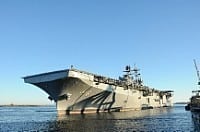
Sen. Roger Wicker (R-Miss.) is pushing for the Navy to get authority to start advance procurement and incremental funding for two amphibious ships after the Navy’s FY ’20 budget request delayed the programs. While the FY ’19 budget appropriated $350 million in advanced procurement for the Navy to spend on the unnamed America-class amphibious assault ship LHA-9 and the second San Antonio-class Flight II Landing Platform Dock LPD-31, the FY ’20 request does not fund either ship. Instead, the service…

 By
By 











